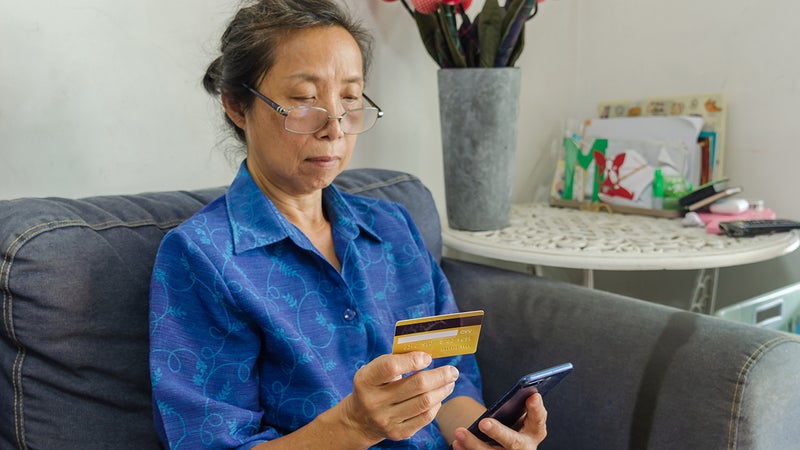How your grace period lets you avoid paying interest on a credit card

The Bankrate promise
At Bankrate we strive to help you make smarter financial decisions. While we adhere to strict , this post may contain references to products from our partners. Here's an explanation for . The content on this page is accurate as of the posting date; however, some of the offers mentioned may have expired. Terms apply to the offers listed on this page. Any opinions, analyses, reviews or recommendations expressed in this article are those of the author’s alone, and have not been reviewed, approved or otherwise endorsed by any card issuer.
Key takeaways
- A grace period is the time between when your credit card billing cycle closes and your bill is due.
- In most cases, credit card issuers don’t charge interest on your purchases during the grace period.
- Once the grace period ends, interest begins accruing on your balances if you haven't paid them off in full.
Nobody enjoys paying credit card interest. Luckily, most credit cards come with a built-in feature that cardholders can use to pay off their balances interest-free: The grace period.
Credit card interest rates can quickly take your balance from manageable to overwhelming. Paying off your monthly statement balances in full each month is the path to avoiding credit card debt. As long as you pay off your statement balance in full, your grace period kicks in and you can make purchases on your credit card without paying interest until the next statement due date. Keep paying off your balance in full each month, and you’ll keep that interest-free grace period going.
Here’s everything you need to know about grace periods on your credit card:
What is a credit card grace period?
A credit card grace period is an interest-free period between when your credit card billing cycle ends and the due date on your bill. While card issuers must give you at least 21 days from the close of a cycle to your due date, they aren’t required to make that time interest-free. But most of them do, which means a cardholder has time to pay off their purchases interest-free during that time — and for much longer than that if they’ve made a habit of paying their balance in full each month.
Grace periods are a key concept to understand if you want to avoid paying interest on a credit card. You may find grace periods referred to in a couple of different ways. A grace period is defined as:
- A stretch of time during which a credit card issuer doesn’t charge interest on your purchases. Assuming you’ve paid your previous balance in full, the grace period kicks in at the start of the next billing cycle and continues through the statement due date.
- The time between when your billing cycle closes until the due date on that statement. By law, issuers must give you at least 21 days between delivering your statement to you and the due date. This period is sometimes referred to as a “grace period,” but it’s important to note that there’s no law requiring it be interest-free.
You should understand both, but the first definition is the most important when it comes to staying out of debt, and it’s the one we’ll focus on in this article. If you have an unpaid balance when your grace period ends, it and any new purchases will begin to accrue interest based on your credit card’s annual percentage rate (APR).
Keep in mind: Grace periods apply to purchases only. Cash advances, balance transfers and transactions made with any convenience checks are usually exempt from a grace period and begin accruing interest as soon as you complete your transaction.
While the best credit cards offer grace periods, some credit cards do not offer interest-free periods at all or only offer very short grace periods. Pay attention to the fine print of your credit card agreement so you know exactly how long you have to pay off your balance before interest charges begin to accrue. In rare cases, purchases begin accruing interest immediately.
How long is the grace period on a credit card?
Thanks to the Credit CARD Act of 2009, lenders are required to get cardholders their bills at least 21 days before payment is due. Most major credit cards count those 21 days, as well as the time from when you made your purchases within the billing cycle, as a grace period as long as you’ve paid your prior balance in full. That means grace periods could be nearly two months long.
How to make the most of your grace period
As long as you stay on top of your credit card balance, you can charge new purchases to your credit card and pay them off before your due date in order to avoid paying interest. If you want to use your grace period to avoid interest on a credit card, consider taking the following steps.
Pay your monthly statement in full and on time
Paying the full amount will help you avoid any interest charges. If you can’t pay your statement balance off completely, try to make a smaller payment (not less than the minimum payment). Any amount remaining on your statement balance will begin to accrue interest — as will any new purchases charged to the card — but the smaller the balance you have, the less you’ll spend on interest.
Give yourself added time between purchases
If you want to get even more usage out of your grace period, time your credit card purchases to take advantage of your card’s billing cycle. Remember, your grace period begins when your billing cycle closes. So if you use your credit card for a large purchase at the beginning of your billing cycle, you have the full cycle plus the grace period before your credit card issuer will begin charging interest on that purchase. That could give you nearly two months of zero-interest borrowing.
Create a budget
It will be easier to manage your monthly expenses if you establish a budget. Additionally, once you understand how to make the most of your grace period, you can treat your credit card like an interest-free loan. As long as you pay your statement balance in full every month before your grace period ends, you won’t have to worry about paying interest on any of your purchases.
What happens if you carry a balance after your grace period?
If you do not pay off your statement balance in full before your grace period ends, you lose the grace period on your credit card. This means that both your current balance and any new purchases will begin accruing interest immediately.
After a few billing cycles of full payments, your credit card issuer is likely to reinstate your grace period if you no longer carry a balance.
If you’d like to avoid paying interest on your credit card, you have two options. You can pay off your balance before your grace period ends, or you can apply for a credit card that offers a 0 percent intro APR on purchases for a time. Using a credit card with a 0 percent intro APR can save a decent amount of money if you know you won’t be able to pay your balance right away. If you take advantage of that full interest-free window, which could last for 18 months or longer, you can save a lot on interest payments.
Interest can add up quickly
Let’s quickly calculate how easily interest can add up if you don’t have a 0 percent intro APR offer. If you have a purchase APR of 16.99 percent (and assuming you make no new purchases during the billing period), your daily interest rate is approximately 0.0465 percent. So, if your balance is $1,000 at the beginning of your billing cycle, by the end of the first day, your balance will be up 0.0465 percent, or 47 cents, to $1,000.47. Then the next day, you will be charged 0.0465 percent interest again, but on the new higher balance of $1,000.47 and so on throughout your billing cycle thanks to compounding interest.
By the end of a 31-day billing cycle, you will have accumulated about $14.43 in interest.
Can you extend your grace period?
There isn’t a hard and fast rule when it comes to extending your grace period. In most cases, you won’t be granted an extended grace period simply by asking your issuer. However, you could try requesting a different billing cycle due date to buy yourself extra time before interest is applied to your balance.
Additionally, you could buy yourself even more time by making purchases with your card immediately after the closing date of the previous billing cycle, which is the beginning of the next billing cycle. As long as you have a plan to pay your balance before its due date, you will be able to carry a balance for as long as possible without being charged interest.
The bottom line
Understanding when to pay a credit card to avoid interest is a critical part of responsibly using your card and being able to take full advantage of the features and perks it offers. It is always advisable to pay off your balance in full each billing cycle, so take advantage of your grace period as extra time to prepare your finances to make that happen.





